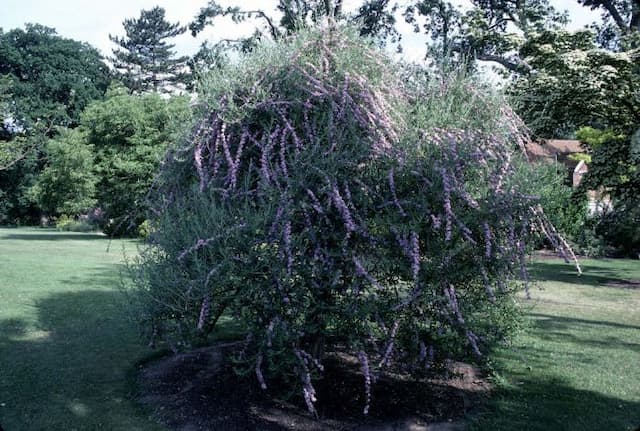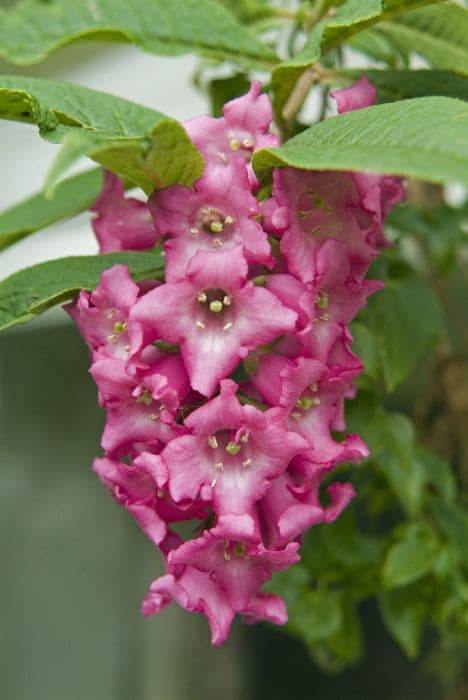Purple mullein 'Rosetta' Verbascum phoeniceum 'Rosetta'

ABOUT
'Rosetta' is a biennial or short-lived, evergreen perennial, producing a basal rosette of dark green leaves and spires of close-packed, saucer-shaped, rich pink blooms in summer
About this plant
 Names
NamesFamily
Scrophulariaceae
Synonyms
Purple Mullein, Temptress Purple Mullein, Phoenician Mullein, Rosetta Mullein
Common names
Verbascum phoeniceum 'Rosetta'.
 Characteristics
CharacteristicsLife cycle
Biennials
Foliage type
Deciduous
Color of leaves
Green
Flower color
Pink
Height
2-3 feet (60-90 cm)
Spread
1-2 feet (30-60 cm)
Plant type
Herb
Hardiness zones
5
Native area
Europe
Benefits
 General Benefits
General Benefits- Attracts pollinators: Verbascum phoeniceum 'Rosetta' flowers are attractive to bees and butterflies, promoting a healthy ecosystem.
- Drought-tolerant: Once established, it can survive with minimal water, making it suitable for xeriscaping or drought-prone areas.
- Easy maintenance: This plant requires little care beyond the basic needs, which makes it ideal for low-maintenance gardens.
- Ornamental value: With its tall spikes of rosy-purple flowers, it provides an eye-catching vertical accent in garden designs.
- Seasonal interest: Offers interest throughout its flowering season, enhancing the garden's aesthetic during that time.
- Resistant to deer and rabbits: It's not a preferred plant for grazing by deer and rabbits, which can help to minimize garden damage.
- Resilience to pests and diseases: Generally resistant to common garden pests and diseases, reducing the need for chemical treatments.
- Versatility in landscape: Can be used in borders, cottage gardens, gravel gardens, or wildflower gardens for various design effects.
- Good cut flower: The flower spikes can be used in fresh floral arrangements, adding beauty indoors as well.
 Medical Properties
Medical Properties- Anti-inflammatory: Traditionally used to reduce inflammation.
- Expectorant: Used to assist in clearing mucus from the airways.
- Demulcent: Contains mucilage which soothes irritated mucous membranes.
- Diuretic: May promote the increased passing of urine.
- Emollient: Can be used externally to soften and soothe the skin.
- Antibacterial: Historically used for its antibacterial properties.
- Astringent: May be used to tighten tissues and reduce discharge.
 Air-purifying Qualities
Air-purifying QualitiesThis plant is not specifically known for air purifying qualities.
 Other Uses
Other Uses- Verbascum phoeniceum 'Rosetta', commonly known as Purple Mullein, can be used as a natural dye source, yielding a variety of colors depending on the mordant used.
- In companion planting, Purple Mullein can attract beneficial insects like ladybugs and lacewings, which help control aphid populations.
- The stalks of Purple Mullein can be dried and used in floral arrangements, bringing a unique vertical element to the design.
- The plant's leaves can serve as a natural tinder for starting fires due to their flammability when dry.
- Purple Mullein can be used as a cover crop in agriculture to suppress weeds and retain soil moisture.
- Some photographers use the towering spikes and blossoms as a natural backdrop or focus point in garden photography.
- The velvety texture of the leaves can be used in sensory gardens, offering a tactile experience for visitors.
- In craft projects, the leaves and flowers can be pressed and used for decorating scrapbooks or making botanical prints.
- The plant has been used traditionally in fish traps in some cultures, where its saponins can stupefy fish, making them easier to catch.
- During periods of scarcity, dried Purple Mullein leaves have been used as a rough substitute for lamp wicks.
Interesting Facts
 Feng Shui
Feng ShuiThe Purple Mullein is not used in Feng Shui practice.
 Zodiac Sign Compitability
Zodiac Sign CompitabilityThe Purple Mullein is not used in astrology practice.
 Plant Symbolism
Plant Symbolism- Healing - Verbascum phoeniceum, commonly known as Purple Mullein, has been used in traditional medicine for its purported healing properties, especially for respiratory ailments.
- Protection - Historically, mullein was believed to ward off evil spirits and negative energies, and it was used in protection charms.
- Purification - The plant is also associated with purification, possibly due to its use in herbal medicine to cleanse the body.
 Water
WaterPurple Mullein should be watered deeply but infrequently to mimic its natural drought-prone habitat. It's best to allow the soil to dry out somewhat between waterings. During the growing season, watering once a week with about one gallon of water per plant should suffice, depending on the climate and soil moisture levels. In hotter, drier periods, twice weekly may be necessary. Always check the soil moisture before watering to avoid overwatering, which can lead to root rot.
 Light
LightPurple Mullein thrives in full sun and should be planted in a location where it can receive at least six hours of direct sunlight daily. It can tolerate partial shade, but flowering may be reduced in less than ideal light conditions. Ensure the chosen spot is free from shadows cast by larger plants or buildings to provide uninterrupted light exposure.
 Temperature
TemperaturePurple Mullein can tolerate a wide range of temperatures but grows best when the daytime temperature is between 65°F and 75°F. It can survive minimum temperatures down to about -20°F, making it suitable for many temperate climates. Conversely, it can tolerate high temperatures as long as the plant is well-watered and the roots are cool.
 Pruning
PruningPurple Mullein should be pruned to remove spent flowers and encourage a second bloom. Deadheading, or cutting off the faded flower spikes, can be done throughout the blooming season. In addition, cutting the plant back in late fall helps maintain a tidy appearance and prepares it for the next growing season. Pruning is also vital to prevent the plant from self-seeding too aggressively.
 Cleaning
CleaningAs needed
 Soil
SoilThe Purple Mullein 'Rosetta' thrives in well-draining soil with added organic matter. The best soil mix is one part garden soil, one part peat or compost, and one part grit or perlite. This perennial prefers a slightly alkaline to neutral pH range, between 6.0 and 8.0.
 Repotting
RepottingPurple Mullein 'Rosetta' does not require frequent repotting and can be repotted every 2-3 years. It's best to repot in the spring, as the plant resumes active growth, when it has outgrown its current container.
 Humidity & Misting
Humidity & MistingPurple Mullein 'Rosetta' is tolerant of a wide range of humidity conditions and does not have specific humidity needs. It grows well in average ambient humidity found in most outdoor environments.
 Suitable locations
Suitable locationsIndoor
Place in bright, indirect light and ensure good air flow.
Outdoor
Full sun to partial shade, protect from strong winds.
Hardiness zone
4-8 USDA
 Life cycle
Life cycleVerbascum phoeniceum 'Rosetta', commonly known as Purple Mullein, begins its life as a seed, requiring light to germinate in late winter or early spring. After germination, it develops a basal rosette of leaves, a stage which can last for several weeks as the plant becomes established. As the weather warms, it enters a vegetative growth phase, producing tall, erect stems that can reach up to 60 centimeters high. The plant then blossoms in late spring to early summer, displaying vivid rosette-shaped purple flowers beloved by pollinators. Following pollination, seeds develop and are dispersed near the parent plant or further afield by wind and animals. Purple Mullein is a short-lived perennial or biennial, often completing its life cycle in two years, after which it dies, leaving seeds to perpetuate the next generation.
 Propogation
PropogationPropogation time
Spring to Summer
The most popular method of propagating the Purple Mullein 'Rosetta' is by sowing seeds. The best time to propagate by seeds is in late winter to early spring. For successful germination, scatter the tiny seeds on the surface of a well-drained seed starting mix in a tray or pot, and lightly press them into the soil. Keep the substrate moist but not waterlogged, and maintain a temperature of around 65 to 70 degrees Fahrenheit (18 to 21 degrees Celsius). It is not necessary to cover the seeds with soil as they require light for germination. Seedlings usually emerge within two to three weeks, after which they can be transferred to individual pots once they have developed true leaves and have grown strong enough to handle.

![Butterfly bush [Berries and Cream]](/_next/image?url=https%3A%2F%2Fplants-admin.emdemapps.com%2Fimages%2Fplants%2F%2Fimages%2F604b650f667be.png&w=640&q=75)






![Butterfly bush [Nanho Blue]](/_next/image?url=https%3A%2F%2Fplants-admin.emdemapps.com%2Fimages%2Fplants%2F%2Fimages%2F604b55d0a6d2d.png&w=640&q=75)